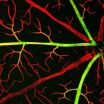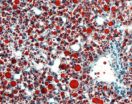(Press-News.org) For the first time, a silicon-based optical fiber with solar-cell capabilities has been developed that has been shown to be scalable to many meters in length. The research opens the door to the possibility of weaving together solar-cell silicon wires to create flexible, curved, or twisted solar fabrics. The findings by an international team of chemists, physicists, and engineers, led by John Badding, a professor of chemistry at Penn State University, will be posted by the journal Advanced Materials in an early online edition on 6 December 2012 and will be published on a future date in the journal's print edition.
The team's new findings build on earlier work addressing the challenge of merging optical fibers with electronic chips -- silicon-based integrated circuits that serve as the building blocks for most semiconductor electronic devices such as solar cells, computers, and cell phones. Rather than merge a flat chip with a round optical fiber, the team found a way to build a new kind of optical fiber -- which is thinner than the width of a human hair -- with its own integrated electronic component, thereby bypassing the need to integrate fiber-optics with chips. To do this, they used high-pressure chemistry techniques to deposit semiconducting materials directly, layer by layer, into tiny holes in optical fibers.
Now, in their new research, the team members have used the same high-pressure chemistry techniques to make a fiber out of crystalline silicon semiconductor materials that can function as a solar cell -- a photovoltaic device that can generate electrical power by converting solar radiation into direct-current electricity. "Our goal is to extend high-performance electronic and solar-cell function to longer lengths and to more flexible forms. We already have made meters-long fibers but, in principle, our team's new method could be used to create bendable silicon solar-cell fibers of over 10 meters in length," Badding said. "Long, fiber-based solar cells give us the potential to do something we couldn't really do before: We can take the silicon fibers and weave them together into a fabric with a wide range of applications such as power generation, battery charging, chemical sensing, and biomedical devices."
Badding explained that one of the major limitations of portable electronics such as smart phones and iPads is short battery life. Solar-boosted batteries could help solve this problem. "A solar cell is usually made from a glass or plastic substrate onto which hydrogenated amorphous silicon has been grown," Badding explained. "Such a solar cell is created using an expensive piece of equipment called a PECVD reactor and the end result is something flat with little flexibility. But woven, fiber-based solar cells would be lightweight, flexible configurations that are portable, foldable, and even wearable." This material could then be connected to electronic devices to power them and charge their batteries. "The military especially is interested in designing wearable power sources for soldiers in the field," Badding added.
The team members believe that another advantage of flexibility in solar-cell materials is the possibility of collecting light energy at various angles. "A typical solar cell has only one flat surface," Badding said. "But a flexible, curved solar-cell fabric would not be as dependent upon where the light is coming from or where the sun is in the horizon and the time of day."
Pier J. A. Sazio of the University of Southampton in the United Kingdom and one of the team's leaders added, "Another intriguing property of these silicon-fiber devices is that as they are so compact, they can have a very fast response to visible laser light. In fact, we fabricated fiber-based photodetectors with a bandwidth of over 1.8 GHz."
INFORMATION:
In addition to Badding and Sazio, other researchers who contributed to this study include lead author Rongrui He, Todd D. Day, Mahesh Krishnamurthi, Justin R. Sparks, and Venkatraman Gopalan from Penn State.
The research was funded by the National Science Foundation, Penn State's Materials Research Institute Nano Fabrication Network, and the United Kingdom's Engineering and Physical Sciences Research Council (EPSRC).
[ Katrina Voss ]
CONTACTS
John Badding: 814-777-3054 (mobile), jbadding@pearl.chem.psu.edu
Pier J. A. Sazio: 44-23-8059-3144, pjas@orc.soton.ac.uk
Barbara Kennedy (PIO): 814-863-4682, science@psu.edu
IMAGES
High-resolution images associated with this research are online at http://www.science.psu.edu/news-and-events/2012-news/Badding12-2012.
CAPTIONS
1. A cross-sectional image of the new silicon-based optical fiber with solar-cell capabilities. Shown are the layers -- labeled n+, i, and p+ -- that have been deposited inside the pore of the fiber.
2. A coiled strand of a meter-long solar-cell junction fiber, thinner than the width of a human hair, which has been created by a team of chemists, physicists, and engineers led by John Badding at Penn State University.
CREDIT
Badding lab, Penn State University
GRANT NUMBERS
Engineering and Physical Sciences Research Council (EP/G028273/1 and EP/I035307/1), National Science Foundation (DMR-0806860 and DMR-1107894), and the Penn State Materials Research Science and Engineering Center (NSF DMR-0820404)
Flexible silicon solar-cell fabrics may soon become possible
2012-12-06
ELSE PRESS RELEASES FROM THIS DATE:
Hubble sees a galaxy hit a bullseye
2012-12-06
In Hubble's image, NGC 922 clearly reveals itself not to be a normal spiral galaxy. The spiral arms are disrupted, a stream of stars extends out towards the top of the image, and a bright ring of nebulae encircles the core. Observing with NASA's Chandra X-ray Observatory reveals more chaos in the form of ultraluminous X-ray sources dotted around the galaxy.
NGC 922's current unusual form is a result of a cosmic bullseye millions of years ago. A smaller galaxy, catalogued as 2MASXI J0224301-244443, plunged right through the heart of NGC 922 and shot out the other side. ...
Biochemists trap a chaperone machine in action
2012-12-06
AMHERST, Mass. – Molecular chaperones have emerged as exciting new potential drug targets, because scientists want to learn how to stop cancer cells, for example, from using chaperones to enable their uncontrolled growth. Now a team of biochemists at the University of Massachusetts Amherst led by Lila Gierasch have deciphered key steps in the mechanism of the Hsp70 molecular machine by "trapping" this chaperone in action, providing a dynamic snapshot of its mechanism.
She and colleagues describe this work in the current issue of Cell. Gierasch's research on Hsp70 chaperones ...
Image of the Carina Nebula marks inauguration of VLT Survey Telescope
2012-12-06
The latest telescope at ESO's Paranal Observatory in Chile -- the VLT Survey Telescope (VST) -- was inaugurated today at the Italian National Institute for Astrophysics (INAF) Observatory of Capodimonte, in Naples, Italy. The ceremony was attended by the Mayor of Naples, Luigi De Magistris, the INAF President, Giovanni Bignami, the ESO representatives Bruno Leibundgut and Roberto Tamai, and the main promoter of the telescope, Massimo Capaccioli of the University of Naples Federico II and INAF.
The VST is a state-of-the-art 2.6-metre telescope, with the huge 268-megapixel ...
Research on blood vessel proteins holds promise for controlling 'blood-brain barrier'
2012-12-06
Working with mice, Johns Hopkins researchers have shed light on the activity of a protein pair found in cells that form the walls of blood vessels in the brain and retina, experiments that could lead to therapeutic control of the blood-brain barrier and of blood vessel growth in the eye.
Their work reveals a dual role for the protein pair, called Norrin/Frizzled-4, in managing the blood vessel network that serves the brain and retina. The first job of the protein pair's signaling is to form the network's proper 3-D architecture in the retina during fetal development. ...
Immune system kill switch could be target for chemotherapy and infection recovery
2012-12-06
Researchers have discovered an immune system 'kill switch' that destroys blood stem cells when the body is under severe stress, such as that induced by chemotherapy and systemic infections.
The discovery could have implications for protecting the blood system during chemotherapy or in diseases associated with overwhelming infection, such as sepsis.
The kill switch is triggered when internal immune cell signals that protect the body from infection go haywire. Dr Seth Masters, Dr Motti Gerlic, Dr Benjamin Kile and Dr Ben Croker from the Walter and Eliza Hall Institute ...
Nobody's perfect
2012-12-06
Researchers at Cambridge and Cardiff have found that, on average, a normal healthy person carries approximately 400 potentially damaging DNA variants and two variants known to be associated directly with disease traits. They showed that one in ten people studied is expected to develop a genetic disease as a consequence of carrying these variants.
It has been known for decades that all people carry some damaging genetic variants that appear to cause little or no ill effect. But this is the first time that researchers have been able to quantify how many such variants each ...
Overestimation of abortion deaths in Mexico hinders maternal mortality reduction efforts
2012-12-06
This press release is available in Spanish and Portuguese.
A collaborative study conducted in Mexico by researchers of the University of West Virginia-Charleston (USA), Universidad Popular Autónoma del Estado de Puebla (Mexico), Universidad de Chile and the Institute of Molecular Epidemiology of the Universidad Católica de la Santísima Concepción (Chile), revealed that IPAS-Mexico overestimated rates of maternal and abortion mortality up to 35% over the last two decades. The research, recently published in the International Journal of Women's Health highlights that Mexico ...
Researchers discover regulator linking exercise to bigger, stronger muscles
2012-12-06
BOSTON - Scientists at Dana-Farber Cancer Institute have isolated a previously unknown protein in muscles that spurs their growth and increased power following resistance exercise. They suggest that artificially raising the protein's levels might someday help prevent muscle loss caused by cancer, prolonged inactivity in hospital patients, and aging.
Mice given extra doses of the protein gained muscle mass and strength, and rodents with cancer were much less affected by cachexia, the loss of muscle that often occurs in cancer patients, according to the report in the Dec. ...
A relationship between cancer genes and the reprogramming gene SOX2 discovered
2012-12-06
A team of researchers from the Spanish National Cancer Research Centre (CNIO), led by Manuel Serrano, from the Tumour Suppression Group, together with scientists from London and Santiago de Compostela, has discovered that the cellular reprogramming gene SOX2, which is involved in several types of cancers, such as lung cancer and pituitary cancer, is directly regulated by the tumor suppressor CDKN1B(p27) gene, which is also associated with these types of cancer.
The same edition of the online version of the journal also includes a study led by Massimo Squatrito, who recently ...
Study IDs gene that turns carbs into fat
2012-12-06
Berkeley — A gene that helps the body convert that big plate of holiday cookies you just polished off into fat could provide a new target for potential treatments for fatty liver disease, diabetes and obesity.
Researchers at the University of California, Berkeley, are unlocking the molecular mechanisms of how our body converts dietary carbohydrates into fat, and as part of that research, they found that a gene with the catchy name BAF60c contributes to fatty liver, or steatosis.
In the study, to be published online Dec. 6 in the journal Molecular Cell, the researchers ...




